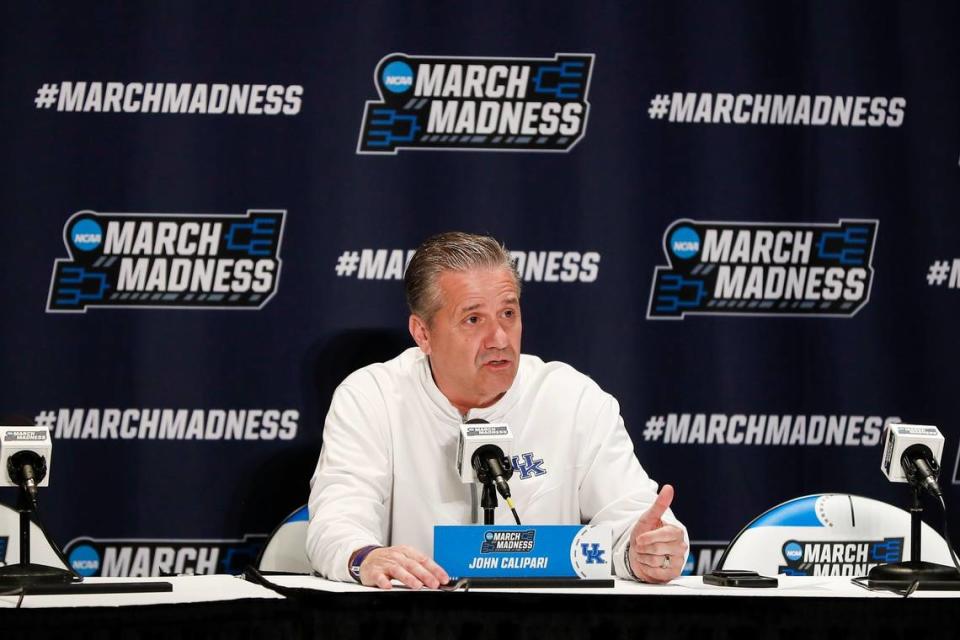Will UK basketball learn the right lessons from the 2023 NCAA Tournament?
The 2023 men’s basketball NCAA Tournament has proven this season’s conventional wisdom right in one major regard.
When not a single No. 1 seed even reached the Elite Eight for the first time in tourney history, it confirmed what had been widely thought throughout this season: that the competitive gap between the perceived top teams in men’s college hoops in 2022-23 and everybody else was not nearly as wide as in a normal year.
That’s how you get a Final Four of Connecticut vs. Miami (Florida) and San Diego State vs. Florida Atlantic. That’s a No. 4 seed (Connecticut), two No. 5 seeds (Miami and San Diego State) and a No. 9 (Florida Atlantic) seed.
That’s how you get two non-power conference teams (the Mountain West Conference’s San Diego State and Conference USA’s FAU) and three first-time Final Four participants (the previous two, plus Miami) in the national semifinals.
It’s also how you get the first Final Four since seeding began without a single former McDonald’s All-American on the roster of any of the participating teams.
A sign of the times: This is the first Final Four without a single former McDonald's All-American since the NCAA tournament began seeding teams in 1979. (Via @ESPNStatsInfo)
— Jeff Borzello (@jeffborzello) March 26, 2023
For those teams that did not fare well in the aptly labeled March Madness of 2023 — a list which would include Kentucky, which still hasn’t gotten out of the first weekend since 2019 — what overarching lesson is there to be drawn from who won and who lost in the ongoing NCAA tourney?
Because the Final Four has so many new faces, including two teams from leagues far from the bright lights of the college hoops “big time,” a new conventional wisdom is forming around the idea that the players acquiring name, image and likeness rights coupled with the greater mobility allowed NCAA athletes by the one-time free-transfer rule is ushering in a new world of unprecedented parity.
Well, maybe.
Contrary to the oft-repeated fear of the rich getting richer, I have always thought NIL opportunities are more likely to disperse talent throughout college sports than concentrate it in a few hands.
Yet let’s not lose sight of the fact that one NCAA Tournament is not much of a sample size. Just last season, the Final Four was filled with some of college basketballs biggest and most familiar brands — Kansas, North Carolina, Duke and Villanova.
Rather than NIL and the one free transfer, the biggest factor that has created the parity that has defined the 2023 NCAA Tournament is the “super-senior” phenomenon that was created when the NCAA granted every athlete enrolled in college in 2020-21 an extra season of eligibility due to the coronavirus pandemic.
If “old has been gold” in the roster construction of NCAA champions ever since 2016 — and it has — the super-senior dynamic has made experience and maturity into the platinum dynamic of March Madness success.
To see the impact on the tournament of rosters laden with fifth-year seniors, one need only peruse the list of such players who played significant minutes for teams that reached this season’s Elite Eight.
Among the nine players who played for San Diego State in the Aztecs’ one-point win over Creighton in the South Region finals were four super-seniors, three conventional seniors and two juniors.
Of the eight players who played for Texas in the Longhorns’ excruciating, come-from-ahead loss to Miami in the Midwest Region finals, there were four super-seniors, a conventional senior, a sophomore and two freshmen.
En route to ousting UK and reaching the East Region finals, Kansas State had five super-seniors plus a conventional senior among its top nine players.
Of the 40 players who started in the 2023 NCAA Tournament Elite Eight, there were 17 seniors (nine super-seniors and eight conventional), nine juniors, 11 sophomores, two redshirt freshmen — and only one single, solitary true freshman.

That’s why Kentucky in 2023-24 cannot afford to rely exclusively on its incoming No. 1-ranked recruiting class to reverse the Wildcats’ recently lackluster NCAA tourney fortunes.
No matter how good the class manned by McDonald’s All-Americans Aaron Bradshaw (No. 5 in the Rivals 150 for the class of 2023), Justin Edwards (No. 4), Reed Sheppard (No. 22) and DJ Wagner (No. 3) plus the lavishly hyped Robert Dillingham (No. 7) turns out to be, it is going to be a steep ask to expect a bunch of teenagers to prevail under NCAA Tournament pressure when they run into teams built around 24-year-old men.
So regardless of how gifted the incoming UK freshmen prove to be, the ultimate fate of Kentucky’s 2023-24 season likely relies on what level of veteran players Calipari can 1.) retain from the current UK roster; 2.) acquire via the free-agent wire that is the transfer portal.
Looking forward, the super-senior dynamic has at least two more seasons before the vast majority of players enrolled in school in 2020-21 will have cycled through.
Until that happens, the ability of coaches to assemble teams built around players with an additional year of both college experience and physical maturity seems likely to have an outsized impact on who makes magic in March.
Kentucky point guard Sahvir Wheeler enters the transfer portal after two seasons at UK
Tracking Kentucky basketball roster moves: Calipari set to meet with players this week
How will Kentucky basketball’s freshman class fare when portal players are the craze?
Five big questions for Kentucky basketball (and John Calipari) as the offseason begins


